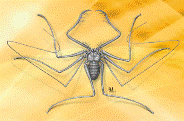Papers in the Biological Sciences

Eileen Hebets Publications
Document Type
Article
Date of this Version
2013
Citation
2013. The Journal of Arachnology 41:349–355. doi 10.1636/B12-71.1
Abstract
This study used radioimmunoassay (RIA) to explore the relationship between levels of hemolymph ecdysteroids and female reproductive behavior in Schizocosa wolf spiders. Specifically, we investigated the relationship between circulating ecdysteroid concentrations in females and 1) likelihood to copulate, or female receptivity [Experiment I— Schizocosa avida (Walckenaer 1837)], 2) time post copulation (Experiment 2— Schizocosa rovneri Uetz & Dondale 1979) and 3) exposure to conspecific male courtship (Experiment 3— Schizocosa uetzi Stratton 1997). In Experiment 1, we expected higher levels of circulating ecdysteroids in receptive versus unreceptive females, based upon prior research demonstrating an increase in receptivity following injections of 20-hydroexyedysone (e.g., Tegenaria atrica C.L. Koch 1843). In contrast, we found no relationship between female receptivity and ecdysteroid levels. Our second experiment compared ecdysteroid levels in mated versus virgin females at three time points following mating trials (24 h, 7 d and 14 d). We predicted low and constant ecdysteroid levels, independent of both mating status and time post mating trial—our results support this prediction. Our third experiment explored the relationship between exposure to conspecific courtship and ecdysteroid levels; again, we found no relationship. Thus, circulating ecdysteroid concentrations were not associated with any aspect of reproductive biology we explored. However, we found a negative trend between female age post maturation and circulating ecdysteroid concentration in the species for which we had the greatest age range, consistent with its role as a molting hormone.
Included in
Animal Sciences Commons, Behavior and Ethology Commons, Biology Commons, Genetics and Genomics Commons


Comments
Copyright (c) 2013 Stubbendieck, Zera, & Hebets. Used by permission.